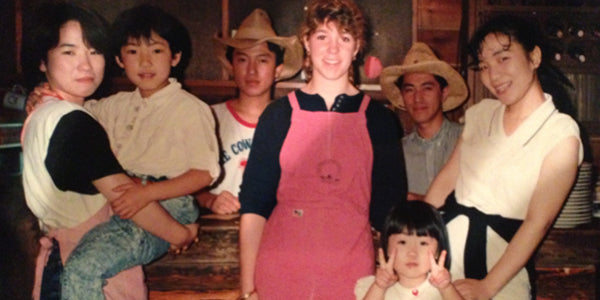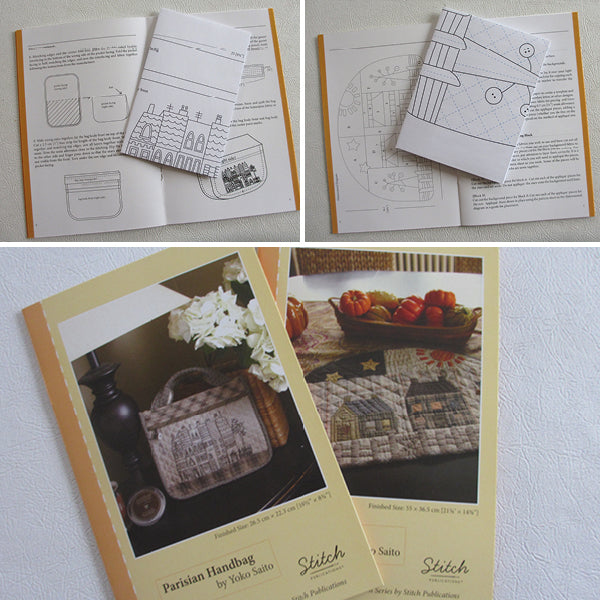By guest blogger Priscilla Knoble, founder of Stitch Publications
SEATTLE, WA I was born and raised in Japan. My parents were missionaries. My mom went over to Japan soon after World War II when General Douglas MacArthur made a plea for help with rebuilding the country. (MacArthur was widely respected in Japan as someone who successfully brought about the reconstruction of postwar Japan and helped to restore the economy, a new constitution and other reforms.)
My dad was an actor in New York who, upon becoming a Christian, decided to go to Japan. My parents met there. My dad was fond of saying that his kids were “Made in Japan.”

I grew up in a little village at the foot of Mt. Fuji that grew green tea and mikan (mandarin oranges). It was an idyllic childhood. There were no gaijin (foreigners) where we were in the 60's and 70's. Until I went away to boarding school in Tokyo in the first grade, I would mostly only see other gaijin when we would get together with other missionary families for a few weeks in the summers.
We mainly spoke English in the house and Japanese the rest of the time, so I was blessed to grow up completely bilingual. Even today I still think, and even dream, in both languages.

In our little village, like so many others in that era, we had small independent stores for different things. There was the vegetable and fruit store, the fish store, the butcher, the office supplies store, etc. I had only seen supermarkets in Tokyo.
One day when I was about five-years old, we saw giant balloons in the sky some blocks away that advertised a new store. Lo and behold, our little village was getting its first supermarket—a two-story building with groceries in the basement and sundry goods on the top floor.
I lived on a street with a bunch of kids. We all hopped on our bikes and rode over to see this phenomenon. As we approached a welcome table, the ladies handed us each our own helium balloon. I’m not sure I’d ever owned one before! We tied them to our wrists and rode home. We all wanted more, so we changed clothes and went back. The ladies handed each of us another balloon!
This was amazing, so we did it a third time. This time, however, the ladies looked at us and said, “You’ve been here before and we can’t give you another one.” We were so sad that they figured it out. How, we wondered? I laugh about it all the time.

My parents taught us how to make things and create from scratch. We cooked, built things, and sewed from a very early age. My brother made a little shirt for his teddy bear on my mom’s Featherweight when he was about six. I learned to sew when I was four and even had a little sewing machine that worked, that my mom bought for me.

By the time I was in elementary school, I was designing my own clothes. My mom gave me her Featherweight to take back to the States when I left for college. While I had seen and used plenty of quilts, I wasn’t introduced to quilting as a craft until the summer I was home from college between my sophomore and junior years.
When a lady from America showed me what she was working on, I was hooked. I went to the fabric store, bought fabric and made my first quilt—a little house block wall hanging. (My mom, at left, still has my first quilt.)
I always thought I would move back to Japan after graduation from university but instead I moved to Seattle. I taught, as well as worked in a Japanese business. Then I moved to the East Coast for a few years where I continued to teach plus I took a part-time job in a quilt shop. My quilting skills and knowledge, as well as my stash, soared during this time.
Although I loved teaching, I missed not having more to do with Japan. At the time, the computer software industry was beginning to expand internationally. So I ended up moving back to Seattle and working for a Japanese localization company, then Microsoft, then Adobe Systems—where I still work today as the Director of International and Strategic Markets for the Creative Cloud.
Between growing up in Japan and traveling there for work over the last 20 years, I've collected many Japanese craft books. A few years ago, a dream began to emerge—bringing Japanese quilting and craft books to the English world. I did research, wrote a business plan and started Stitch Publications. It’s a perfect union of my Japanese experiences, my love of quilting and fabric, and my career in international business and publishing software.
Stitch Publications is truly unique from other publishing companies. Not only do I own the company, but I do the translation, layout and virtually everything else. (Shipping and handling is managed by a friend.)


I buy the rights to books that are already published in Japanese as well as find patterns that have never been published. Then I translate and redesign them for the English marketplace.
Being able to translate natively (rather than as a learned language) is very important when getting to the heart of the original author’s intent—particularly in areas of a book that are not directions. Additionally, when I don’t understand the instructions—because sometimes Japanese patterns are fairly cryptic—I stop and make a sample so I can better explain the step in English.
I’m often asked about my own style. I do love the calming aspect of Japanese Taupes. But I love all fabric and fiber. (Did I mention that I knit, spin, weave and pretty much try anything that has to do with fiber or fabric?) I truly love so many different color schemes and fabrics. I design some of my own quilts and like to go to the workshops of some of my favorite designers to expand my own ideas—such as Anna Maria Horner’s Craft South workshop for a fun weekend.

I’ll always be happy to be a quilter who embraces anything that I like at any given time, and appreciates all the artistry and creativity that goes into any kind of quilt. I’m currently remodeling my house with a big studio as part of the plan. I can’t wait to get all of my fabric and machines out again.

I never expected I’d leave teaching to work in software, or start a publishing company and an online retail shop. I love hanging out with the best people—quilters and fabric lovers. My only regret is that I don’t have enough time to make all the things I want. I’m sure life will keep changing and that time will come.


To purchase these patterns +click here









